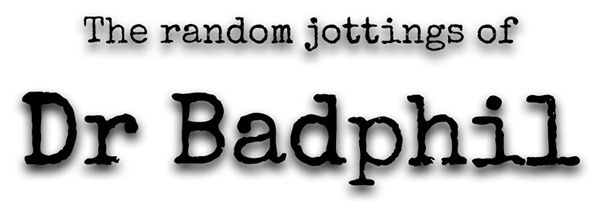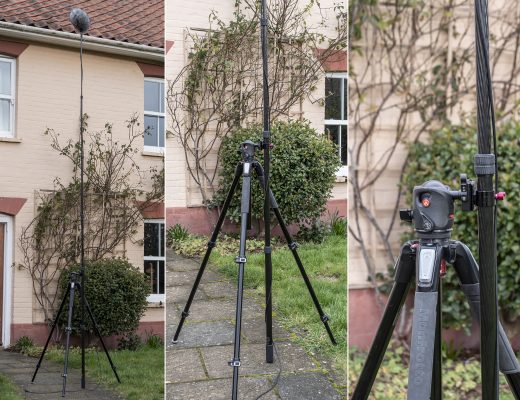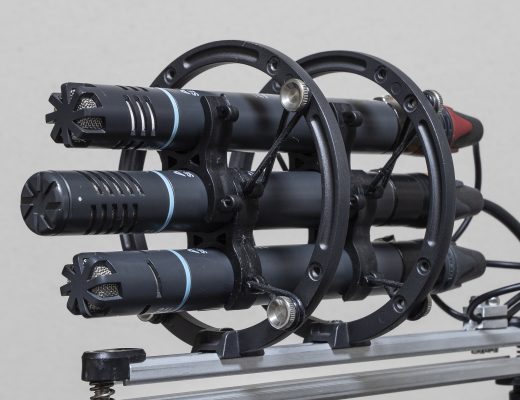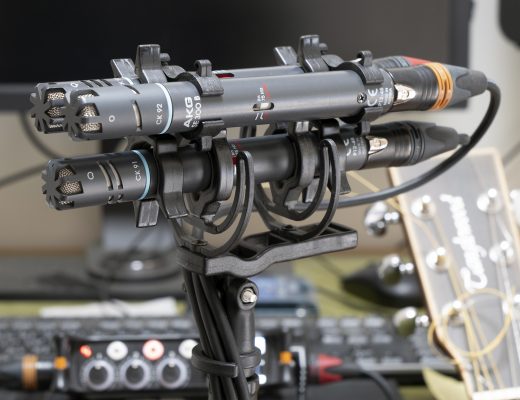
Introduction
It’s funny how reluctant some are to try an omni as the mid mic in a mid-side pair (seemingly afraid that this will make for a mono recording) despite it often being the best tool for the job. But I have had many queries now about whether a wide cardioid will strike a sweet spot between an omni and a cardioid when paired up with an MKH 8030 for mid-side recording. Normally, I swap between omni, cardioid and supercardioid mid mics, but recently, thanks to the good folks at Sennheiser, I have extended my available mid-mic options to include the wide cardioid MKH 8090. And so has begun my exploration as to whether – and this is said only partly tongue-in-cheek – it is something of a Goldilocks mic, hitting the perfect balance between omni (MKH 8020) and cardioid (MKH 8040) options, or, alternatively, whether – in practical use – for many it represents too fine a mid-point between these polar patterns, if, indeed, it can be described as a ‘mid-point’.
These things are personal, of course, reflecting both taste and subject matter, but in this blog post I will focus on a series of recordings made with the different mid-side pairs at the same time, so hopefully it will be of some use to a few readers – especially those who cannot try the different polar patterns before buying. And, although I have demonstrated the supercardioid (MKH 8050) mid-mic options previously, in comparison to the MKH 8020 and MKH 8040, I have included it again here for completeness. I have omitted the Sennheiser shotgun mid-mic options (MKH 8060 and MKH 8070) for three good reasons: first, mid-side recording with an interference tube mid mic is a very different beast and usually, though not always, for very different purposes than field recording or music recording; second, it is very hard to think of a set-up that could adequately cope with simultaneous recordings or such differently sized mid mics (well, not one that doesn’t involve at least four fig 8s); and, third and most conclusively, I don’t have either! Likewise, it would be rather tricky to include a fig 8 as the mid mic in a typical windshield, given the required orientation of the mic.
The specs
I don’t want to repeat what can be read in detail on Sennheiser’s website, but, nonetheless, a quick comparison of the polar and frequency response charts is a useful starting point, not least as they are rarely seen grouped together for these four mics.

The most obvious feature of the polar pattern of a wide cardioid such as the MKH 8090 is the absence of a null, with the pattern looking rather that of an omni, albeit consistently reduced at the rear by around 7dB.

In contrast to the situation with polar plots, the frequency response graphs see the MKH 8090 wide cardioid look much more like its cardioid sibling than the omni. The two most noticeable differences from the cardioid are the earlier high-frequency peak and the slightly flatter curve below 100Hz: this is still a long way from the MKH 8020 omni with its almost flat response down to 10Hz.

Test rig
Even rigging four alternative mid mics is no doddle, especially for outdoor field recording, so I have done some thinking and, inevitably, a bit of 3d printing to make a suitable mount. Although, as readers of this blog will know, I am not overly concerned about the often rather theoretical (or at least often imperceptible) issues of shadowing, even I think a cluster of four mics around a single fig 8 seems a bit too congested, so I split the mics into two pairs each with its own MKH 8030 side mic, spacing the two groups of mics 170mm apart on a 3d-printed bar I made up, and mounted within my roomy Mega-Blimp. It is not perfect, of course, but each MS pair can’t occupy exactly the same space at the same time and be free of other mics nearby, so its is a reasonable compromise, and one, I feel, that doesn’t obscure or misrepresent the differences between the various pairs.
Village street
Although the garden has changed dramatically here over recent months (much of the reason why blog posts have been a little thin on the ground of late!), the nominally quiet village street – used as a frequent test bed for me – seems as noisy as ever, with a ripe mixture of sounds. In the recordings below, you can hear the curious thumps from inside a Waitrose van delivering to a neighbour, followed by its departure, along with passing vehicles and birdsong.
First up, we have MS with the omni MKH 8020 mid mic:
Second, we have MS with the wide cardioid MKH 8090 mid mic:
Third, we have MS with the cardioid MKH 8040 mid mic:
And finally we have MS with the supercardioid MKH 8050 mid mic:

Down at the station
Risking large crowds on a bank holiday Monday, I tootled off to Holt station on the North Norfolk Railway, which is another familiar haunt of mine for mic tests, positioning myself a little way from the platforms, opposite the signal box and right next to a signal (I do like the double clunk the latter makes). Funnily enough, it was unexpectedly quiet in terms of people, although the distant hum of traffic and the more disturbing near continuous thunder of aeroplanes overhead were ever present. Here is a snippet, with the signal changing and then a small 0-6-0ST saddle tank setting off, pulling a short train of three Victorian carriages and leaving another train (pulled by an xxxx) hissing steam at the platform:
Following the same sequence as before, first up we have MS with the omni MKH 8020 mid mic:
Second, we have MS with the wide cardioid MKH 8090 mid mic:
Third, we have MS with the cardioid MKH 8040 mid mic:
And finally we have MS with the supercardioid MKH 8050 mid mic:
Conclusions
In the strict sense there are no universal conclusions to be drawn from these tests, with their purpose being simply to illustrate the differences in the polar patterns of the MKH 8090 and its MKH 8020, MKH 8040 and MKH 8050 siblings when used as the mid mic in a mid-side pair. Inevitably, to some these tests will serve to show how the less directional MKH 8090 and MKH 8020 mid mics work well and are viable alternatives to the more commonly used cardioid and supercardioid mid mics. To others, these tests will show how radically different the four mid mics are. Such is the nature of listening tests even without confirmation bias rearing its ugly head. From a personal view, and drawing on wider use than the few test clips presented here, I have been very impressed by the stereo image presented in mid-side with the MKH 8090 mic. Unless more rear rejection is needed from the null of a cardioid or the deeper bass response of an omni is required (and often the bottom end of the MKH 8020 needs rolling off in field recordings), the MKH 8090 is a compelling option, and one I have been using increasingly in my field recordings. In short I am so glad to have it in my arsenal of mics. Now making such finely gradated choices between polar patterns can be hard when field recording compared, say, to setting up mics for an acoustic music recording in a more controlled indoor space, due to the fact that outdoors sound sources can be unpredictable and constantly swapping mics can become impractical, so, in that sense, having an option between a cardioid and an omni can just make life more complex. But, equally, field recording can involve frequent recordings of the same sound source, or similar sound sources, in familiar or similar locations, and for many an experienced recordist having more finally gradated choices in polar patterns can be useful. And if you are just kicking off with mid-side recording and are uncertain as to which initial mid-mic polar pattern to choose, then, just possibly, this post might provide some food for thought.




8 Comments
The 20 as mid sounds fantastic. I’d never considered MS could be recorded with anything wider than a standard cardioid in centre.
You are not alone, Oliver: so many think omni mid-side is a non-starter, and are surprised when they hear just how good it can sound. I do like the MKH 8090 too, but, obviously, it doesn’t have that bottom end of a pure pressure omni.
Cheers, Roland
I prefer using the MKH 8090 if I don’t need the low end that the 8020 provides.
When I started using mid-side with a cardioid mid 25 years ago for video production, I noticed that when using an analog surround sound decoder sound sources from rear left and rear right was routed to the rear speakers. I got free surround encoding by using mid-side recording. That was kind of fun, but whatever the surround decoder routed to the rear speakers was sound with 180⁰ phase shift between the left and right stereo channels. And that explains why I prefer using a wide cardioid or Omni mid microphone.
Hi Roland,
Thanks for your detailed comparisons, the recordings are very interesting and informative to hear side by side.
I wanted to ask your thoughts re: recording ambiences—my main rig is a pair of spaced omnis, which sound wonderful but even in quiet locations manage to pick up huge amounts of low end from passing motor vehicles/trains that are not nearly as evident when actually in the space.
My questions are: 1, what is a reasonable low cut filter setting in your opinion to help with this rumble, and 2. would a setup built around wide cardioids (either in MS or spaced AB) help to mitigate this issue without compromising too much in terms of the general spread/feel of the recordings?
I fear that with it now so difficult to find locations free from this rumble, recordings made with omni mics need to be edited in post, which seems a shame and in opposition to their natural characteristics.. Editing is also a real rabbit hole I prefer to avoid as much as possible!
Perhaps this is why ORTF setups with their dual cardioids are so popular
Thanks again for your work and your time.
Robert
Hi Robert,
Glad you found the comparisons useful. Yes, low frequencies seem less evident in the environment until you put headphones on/play back. In terms of what low-cut filter setting seems reasonable to reduce your unwanted rumble, that is, of course, nigh on impossible for me to suggest: it will depend on what settings your recorder/mixer allows, whether you have any pre-recorder/mixer options (on mic or, as with the Nanoshields, windshield etc.), what mics you are using, and, most vitally, what/where you are recording and what is acceptable rumble to you. The most straightforward answer to that is to apply some different HPFs in your DAW to some existing recordings at, say, 18dB per octave (or whatever your recorder/mixer offers) and make a judgement. You can then apply that in the field if you don’t want to do it in post. As for using wide cardioids, this won’t make a huge difference to the spaced pair ‘feel’, but, obviously, using one in an MS rig will sound very different to an omni spaced pair. I doubt if avoidance of excessive low end is a significant reason for popularity of ORTF, although, for field recording, directional mics can help remove distracting sounds and, of course, give whatever stereo image you are after. Which comes to the nub of it: I would select a mic pair (or more than a pair if using a more complex array) based on the stereo/surround sound you want/suits the subject, and deal with any unwanted low-end. Unless the latter is causing mic overloading, is distracting monitoring in the field, or you know from experience what you can roll-off (e.g. I would normally have an HPF for dialogue recording, typically at 80Hz, even higher for higher voices) I would deal with this in post. It’s not that much of a rabbit hole.
Cheers,
Roland
Hi Roland, thanks for your thoughtful response. You’re right about the lack of a one-size-fits-all solution, of course. For an example, I was recording some green frogs recently, and their calls registered on the spectrum as low as 70-80hz.. Ruling off at 120-160hz makes for a cleaner recording by eliminating distant rumble, but sacrifices some of that richness . I suppose the answer is, to get a better recording, but I’m interested as to how you might change your technique/process the recording in this situation..
Hi Robert,
Well, yes, you don’t want to roll off the bottom end of the subject matter. Again, it is nigh on impossible to advise on an approach to recording when you are not there nor understand all the factors relating to it. When you say ‘I suppose the answer is, to get a better recording’ then that may well be right. For example, I have been working on a steam railway sound effects library on and off for a year or so now, and one of the most difficult sounds to record is a quiet English spring/summer day (insects buzzing, birds singing) and then, in the far distance, a train just coming into audibility and then coming right past the mics. The easy part was establishing the best location (at the entrance to a cutting, so that the land mass cuts out unwanted noise), and with an uphill so the steam loco has to work hard (and sound all the better); equally easy was choice of mic array (from experience), position (pretty constrained) and direction (obvious). Levels are no problem. Weather: well no point going when the wind is in the wrong direction or too strong,or it is raining. But getting a good recording has been extraordinarily difficult: the trains run to their timetable, so there is one chance each time effectively; it is a fairly long recording (several minutes) and involves very quiet levels (to start with); and getting several minutes of even rural Norfolk with no small aeroplanes or helicopters, passenger jets, people walking/cycling, dogs barking, a chainsaw, or something unusually loud on the fairly distant road, is against the odds. So it has meant trying and trying again. I’ve come close to what I want, but still think it could be better. Just like a landscape photographer will go to the same place again and again to get the right light and the exceptional photo. Sometimes the effort is different, especially in the natural world: waiting in a hide patiently to get the close-up sound: going through hours of drop-rig recordings (and risking gear for this) to see if you struck lucky; getting up at 3 a.m. etc. etc. Anyway, I ramble: in short, the gear and its use is often straightforward, but to get many sounds well recorded without those you find intrusive usually comes down to persistence and, perhaps, accepting a closer sound (itself often hard won) than a wider perspective. Now whether it is worth it is another matter altogether!
Cheers,
Roland
Well said! As you say, I have been out late at night and early in the morning, persistence is key.
Frogs, like trains, keep a schedule that I have come to know quite well now, and my desired recording is perhaps more similar to a train approaching than you might think, with the emergence of the chorus from a quiet backdrop developing into a very loud, all encompassing sound and then dying away again to silence. Tricky, but if it were easy we wouldn’t be doing it!
Best of luck with your project, I look forward to hearing future recordings.
Robert